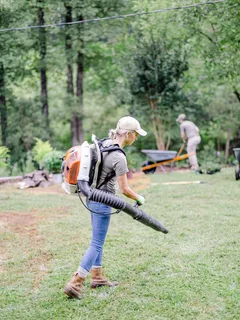Backpack leaf blowers are powerful tools designed for heavy-duty yard work, and when shopping for one, you’ll often see two main specifications: CFM and MPH. These two terms can be confusing for buyers who aren’t familiar with what they actually represent. In this article, we’ll break down what CFM and MPH mean in a backpack leaf blower – explained in simple terms to help you make the right choice for your needs.
Understanding CFM – Cubic Feet per Minute
CFM, or Cubic Feet per Minute, measures the volume of air that the leaf blower can push out. Think of it as the amount of air the machine moves in a minute. A higher CFM means the blower can move more leaves, debris, or grass clippings in less time.
Why CFM Matters:
- Clearing large areas: High CFM is crucial if you’re dealing with wide spaces like lawns, parks, or commercial properties.
- Wet or stubborn debris: A higher volume of air helps dislodge heavier or wet leaves more effectively.
- Efficiency: More air movement means fewer passes to clean up an area.
For backpack leaf blowers, typical CFM ratings range from 400 to over 900, with commercial-grade models offering higher outputs.
Understanding MPH – Miles Per Hour
MPH, or Miles Per Hour, refers to the speed at which the air comes out of the blower’s nozzle. It tells you how fast the air is traveling, which affects the force or impact of the air on debris.
Why MPH Matters:
- Lifting heavy debris: High MPH helps lift compacted leaves, sticks, and other debris off the ground.
- Precision blowing: Faster air is useful when you want to blow leaves into neat piles or specific directions.
- Tough corners and edges: High-speed air gets into cracks, around bushes, and tight spots more effectively.
Backpack leaf blowers typically range from 150 MPH to over 250 MPH, depending on the model.
CFM vs. MPH – Which Is More Important?
When it comes to what CFM and MPH mean in a backpack leaf blower – explained together, it’s important to note that neither CFM nor MPH alone determines how powerful or effective a blower is. You need a balance of both.
- High CFM, low MPH: Moves a lot of air, but not very fast—better for light, dry leaves.
- Low CFM, high MPH: Moves air quickly, but not much of it—not ideal for big jobs.
- Balanced CFM and MPH: Offers the best performance for both residential and commercial tasks.
A good rule of thumb is to look for a backpack leaf blower with a CFM of 500+ and an MPH of at least 180+ for solid, all-around performance.
Choosing the Right Backpack Leaf Blower
When shopping, look beyond just brand or price. Focus on the CFM and MPH ratings, and consider:
- Size of your property
- Types of debris you commonly deal with
- Comfort and weight of the unit
- Fuel type (gas or battery-powered)
Knowing what CFM and MPH mean in a backpack leaf blower – explained in practical terms can help you avoid overpaying for unnecessary power or underbuying a model that won’t get the job done.
Final Thoughts
To sum up, understanding what CFM and MPH mean in a backpack leaf blower – explained clearly, helps you make informed decisions when buying one. CFM measures the volume of air, while MPH measures the speed of that air—and both work together to determine the effectiveness of your leaf blower. Choose a model with the right balance for your specific needs, and your yard cleanup tasks will become faster and more efficient.


